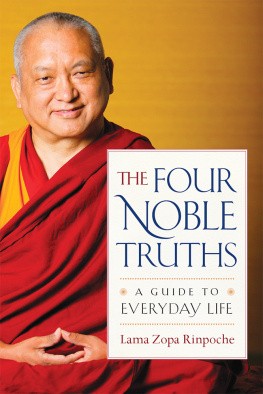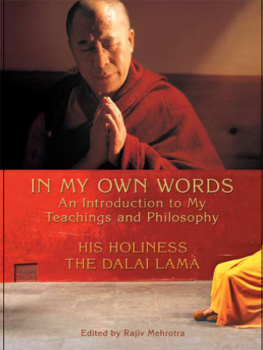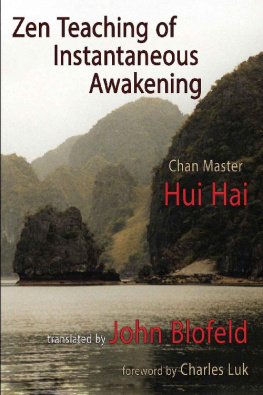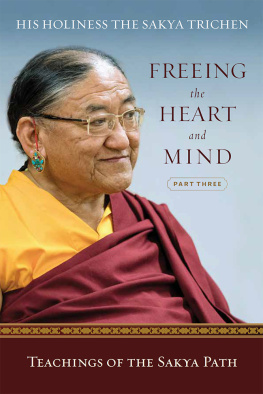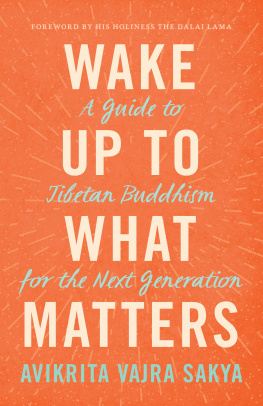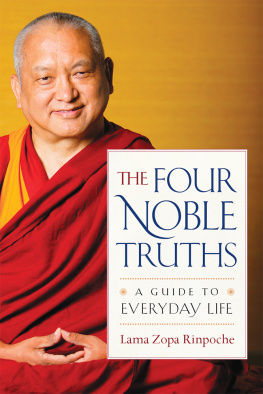Parting from the Four Attachments
His Holiness Sakya Trizin
Parting from the Four Attachments
Teachings given in Merigar (Italy)
25-28 June 1998
Edited by Elisa Copello
with the collaboration of Andy Lukianowicz

Shang Shung Publications
Any errors are due to the transcription and translation and do not reflect the original teachings.
Cover photo of Sakya Pandita courtesy of Himalayan Art
Cover design by Kasia Skura
2011 Shang Shung Institute
Localita Podere Nuovissimo
58031 Arcidosso (GR) Italy
www.shangshunginstitute.org
www.shangshungpublications.org
info@shangshunginstitute.org
Table of Contents
The Right Motivation
First of all, I wish to take this opportunity to extend my very warm greetings to Chgyal Namkhai Norbu Rinpoche as well as to all the Community here and to all the people who have come to this teaching. I would also like to thank the Community very much for inviting me here and giving us such a warm reception in this beautiful place. We are very well rested and we are enjoying the weather, the scenery and everything. Today I will be giving teachings on Parting from the Four Attachments and so, before we begin the teaching, first of all, it is our tradition to recite the Lineage Gurus Prayers. We can recite it together, because I believe all of you have been distributed a copy of it.
Before we receive the teaching, the very first thing is to create the right motivation, because whenever you receive teachings or whatever practice you do, where it leads to depends on one's motivation. The motivation of course has many different levels, but if a teaching has to become a Mahayana teaching, it is very important to have or to create the highest motivation. So the purpose of receiving teachings is not for just one's own sake but for the sake of all sentient beings as wide as space. It is in order to save them from suffering and in order to place them on the path of bliss, for the sake of all limitless sentient beings, that one must attain full enlightenment. Such enlightenment does not rise without proper cause and conditions, therefore first of all in order to attain enlightenment one must receive the holy teaching and after receiving it, whatever is mentioned in it must be diligently applied on the path. When you receive teachings, you must watch your behaviour: as far as the body is concerned you must sit in a respectful position, which means that lying down or sitting in different ways is not allowed unless you are physically handicapped. Verbally you must remain in complete silence, and mentally you must concentrate on every word of the teaching. One should listen to the teachings with great joy, free from the three faults of the container. This means that if the container is upside down, then whatever you try to pour into it, nothing goes into it. Similarly if you are sitting in this temple but your mind is distracted by other things, then you cannot hear or you cannot hold any deep meaning, so this is called the fault of the upside down container.
The second fault of the container occurs when the container is in an upright position but with a hole underneath: so whatever you pour from the top, it leaks out and nothing remains in the container. Similarly even though you hear, trying to pay attention and to remember what is being taught, you will not hold it: you hear, but you forget, that is to say that when you reach the middle of the teaching, you have forgotten the beginning and when you reach the end of the teaching, you have forgotten the middle part and by the time the teaching is over, you cannot remember anything. So this is called the second fault of the container.
Now we come to the third fault of the container: even if the container is in an upright position and there are no holes underneath, but there is dirt inside, then whatever good things you pour in it, they get spoiled by the dirt and you cannot use them. Similarly if one has faults then it is not good. Therefore not only should the container have the correct upright position with no holes, but it is also important that the container should be clean.
Which are the dirty things? There are six faults: the first one is pride about one's race, pride about one's knowledge, etc. No qualities can remain because of the fault of pride, that is why fault number one is pride.
The second fault is being disrespectful, that is to say that even though you are receiving teachings you have no faith in the teacher or in the teaching. So you are listening just to gain ordinary knowledge or out of curiosity. If you are receiving teachings in this way it is not right. The third fault is when there is no real interest in the teaching. The fourth is when your mind is distracted by outer objects or when your mind is roaming around, so that there is no real concentration on the teaching. The fifth is that, even if you are not distracted by outer objects, your mind is dull and it is inwardly sleeping, preventing you from concentrating or understanding the teaching. The sixth is being impatient, because the teaching is too long or because we have no capacity to understand it, etc. So, being free from these faults, we should receive teaching with the six intentions: we should consider the Master our spiritual teacher, like a spiritual doctor; the Dharma like medicine; ourselves like a patient; defilements (hatred, pride, attachment etc) like severe illnesses; and the practice of Dharma like a medical treatment. The sixth intention is the wish that, through the practice and because Buddha has never deceived, but, on the contrary, has always been truthful, the holy Dharma might remain in this universe forever. With these six intentions one should receive the teachings.
Thus if one is free from these faults and receives the teaching properly, then receiving the teachings itself includes all the main practices of the Bodhisattva, called the six paramitas or six perfections. The first is the perfection of generosity: in this case, from the disciple's side it implies the mandala offering and from the guru's side, giving teachings. So all this includes the perfection of generosity. The second is moral conduct, which means abstaining from negativities coming from non-virtuous deeds; so while you are receiving teachings you should refrain from negative deeds. Besides, by receiving teachings you gain knowledge about the right and wrong way, so this corresponds to moral conduct. The third is patience: while you are receiving teachings, you bear physical discomfort or whichever discomfort there might be, so in this way you practise patience. The fourth is endeavour, which is interest or enthusiasm in practising virtuous deeds, therefore listening to the teachings, or from the teacher's side explaining the teachings and from the disciple's side receiving teachings with great enthusiasm and interest. The fifth is called concentration on a single point: the mind is single-pointedly concentrated on the meaning of the teaching. So the perfection of concentration is included here. The sixth is wisdom: through words, one will be able to differentiate and understand the actual meaning and consequently gain wisdom: that is why it is called the perfection of wisdom. So, free from faults and in the right way, one should receive the teachings.
The Origin of this Teaching
This teaching, the path of all Buddhas of the past and of the future that contains all the deep meanings of all the Sutras combined in a practical way, is known as the Mind Training or Pith Instructions, presented by the great masters in the most practical way through their own experience. The history of this teaching is this. When the great Lama Sakyapa was twelve years old, his spiritual master suggested that, since he was the son of a great spiritual master he should study the teaching; however in order to study the teaching he needed first to acquire wisdom. In order to acquire wisdom, he had to practise Manjushri, the manifestation of all the Buddhas' wisdom. Sakyapa's spiritual master, Pari Lotsawa, one of the greatest translators, gave him the initiation of Manjushri and all the teachings related to Manjushri and then asked his disciple to do a meditation retreat. Actually the great Lama Sakyapa Kunga Nyingpo was fully enlightened and an emanation of both Manjushri and Avalokiteshvara combined together, but since he had taken human rebirth and had a human body, in the eyes of common people he had to follow the human way of life. So he was born as a child and then he proceeded step by step, studying, acquiring wisdom and so forth. With the help of his spiritual master he practised the Manjushri meditation for six months. In the beginning there were some signs of obstacles, which vanished through his practice of the wrathful deity known as Blue Achala [ Wrathful form of Mahavairochana -- Note by A. Lukianowicz ].


